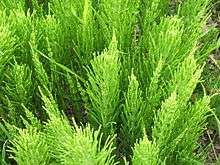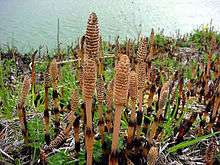Equisetum arvense
| Equisetum arvense | |
|---|---|
 | |
| Photosynthetic summer foliage | |
| Scientific classification | |
| Kingdom: | Plantae |
| Division: | Pteridophyta |
| Class: | Equisetopsida |
| Order: | Equisetales |
| Family: | Equisetaceae |
| Genus: | Equisetum |
| Subgenus: | E. subg. Equisetum |
| Species: | E. arvense |
| Binomial name | |
| Equisetum arvense | |
| Synonyms[1] | |
| |
Equisetum arvense, the field horsetail or common horsetail, is an herbaceous perennial plant in the Equisetopsida (the horsetails), native throughout the arctic and temperate regions of the northern hemisphere. It has separate sterile non-reproductive and fertile spore-bearing stems growing from a perennial underground rhizomatous stem system. The fertile stems are produced in early spring and are non-photosynthetic, while the green sterile stems start to grow after the fertile stems have wilted and persist through the summer until the first autumn frosts.[2][3] It is sometimes confused with mare's tail, Hippuris vulgaris.[4]
Etymology
The specific epithet arvense is from the Latin "arvum", meaning "ploughed", referencing the growth of the plant in arable soil or disturbed areas. The common name "common horsetail" references the appearance of the plant that when bunched together appears similar to a horse's tail.[5]
Description
Equisetum arvense creeps extensively with its slender and felted rhizomes that freely fork and bear tubers. The erect or prostrate sterile stems are 10–90 cm (3.9–35.4 in) tall and 3–5 mm (0.12–0.20 in) diameter, with jointed segments around 2–5 cm (0.79–1.97 in) long with whorls of side shoots at the segment joints; the side shoots have a diameter of about 1 mm (0.039 in). Some stems can have as many as 20 segments. The solid and simple branches are ascending or spreading, with sheaths that bear attenuate teeth. The off-white fertile stems are of a succulent texture, 10–25 cm (3.9–9.8 in) tall and 3–5 mm (0.12–0.20 in) diameter, with 4–8 whorls of brown scale leaves and an apical brown spore cone. The cone is 10–40 mm (0.39–1.57 in) long and 4–9 mm (0.16–0.35 in) broad.[2] The fertile stems are typically precocious and appear in early spring.[6] It is little changed from its ancestors of the Carboniferous period.
The plant is difficult to control due to its extensive rhizomes and deeply burrowing tubers. Fire, mowing, or slashing is ineffective at removing the plant as new stems quickly grow from the rhizomes. Some herbicides remove aerial growth but regrowth quickly occurs albeit with a reduction in frond density.[5]
E. arvense is a nonflowering plant, multiplying through spores. It absorbs silicon from the soil, which is rare among herbs. It has a very high diploid number of 216 (108 pairs of chromosomes).[2]
Habitat and distribution
Equisetum arvense grows in a wide range of conditions, in temperatures less than 5 °C (41 °F) to greater than 20 °C (68 °F) and in areas that receive annual rainfall as low as 100 mm (3.9 in) and as great as 2,000 mm (79 in). It commonly occurs in damp and open woodlands, pastures, arable lands, roadsides, disturbed areas, and near the edge of streams. It prefers neutral or slightly basic clay loams that are sandy or silty, especially where the water table is high, though it can occur occasionally on slightly acid soils.[5]
The plant is widespread in the northern hemisphere, growing as far as 83° North in North America and 71° North in Norway, Sweden, Finland, and Russia and as far south as Texas, India, and Iran. It is less widespread in the southern hemisphere, but it occurs in Argentina, Brazil, Chile, Madagascar, Indonesia, Australia, and New Zealand.[5]
Beneficial uses

The plant contains several substances that can be used medicinally. It is rich in the minerals silicon (10%), potassium, calcium, manganese, magnesium and phosphorus, phytosterols, dietary fiber, vitamins A, E and C, tannins, alkaloids, saponins, flavonoids, glycosides and caffeic acid phenolic ester. The buds are eaten as a vegetable in Japan and Korea in spring. All other Equisetum species are toxic.

In polluted conditions, it may synthesize nicotine.[7] Externally it was traditionally used for chilblains and wounds.[8] It was also once used to polish pewter and wood (gaining the name pewterwort) and to strengthen fingernails. It is also an abrasive. It was used by hurdy-gurdy players to dress the wheels of their instruments by removing resin build up.[9]
Equisetum is used in biodynamic farming (preparation BD 508) in particular to reduce the effects of excessive water around plants (such as fungal growth). The high silica content of the plant reduces the impact of moisture.[10]
E. arvense has been used in traditional Austrian herbal medicine internally as tea, or externally as baths or compresses, for treatment of disorders of the skin, locomotor system, kidneys and urinary tract, rheumatism and gout.
Harmful effects
.jpg)
Equisetum arvense is toxic to stock, particularly horses.[11]
It was introduced into New Zealand in the 1920s and was first identified as an invasive species there by Ella Orr Campbell in 1949.[12] It is listed on the National Pest Plant Accord, prohibiting its sale, spread and cultivation.[13]
References
- ↑ "Name - Equisetum arvense L." Tropicos. Missouri Botanical Garden. 2018. Retrieved 18 August 2018.
- 1 2 3 Hyde, H. A., Wade, A. E., & Harrison, S. G. (1978). Welsh Ferns. National Museum of Wales ISBN 0-7200-0210-9.
- ↑ Flora of North America: Equisetum arvense
- ↑ Dao-Lan, Xu; Jian-Guo, Cao; Quan-Xi, Wang; Xi-Ling, Dai (November 2015). "Cloning and Characterization of DEAD-box RNA Helicases Gene from the Fern Equisetum arvense". Plant Diversity And Resources. 36 (6): 715–722. doi:10.7677/ynzwyj201414036.
- 1 2 3 4 W. T. Parsons, William Thomas Parsons, E. G. Cuthbertson (2001). "Noxious Weeds of Australia" (illustrated, revised ed.). Csiro Publishing. p. 14. ISBN 9780643065147. Missing or empty
|url=(help) - ↑ Merrit Lyndon Fernald (1970). R. C. Rollins, ed. Gray's Manual of Botany (Eighth (Centennial) - Illustrated ed.). D. Van Nostrand Company. p. 4. ISBN 0-442-22250-5.
- ↑ Bebbington, A. "Toxicity of Equisetum to Horses". Retrieved 1 December 2010.
- ↑ Howard, Michael. Traditional Folk Remedies (Century, 1987); p.159-160
- ↑ La Vielleuse Habile, Jean-Francois Bouin, 1761, page 19.
- ↑ Kearny, Peter. "Bio Dynamic Prep 508". Bio Dynamic Prep 208. City Food Growers. Retrieved 1 June 2011.
- ↑ "Equisetum arvense". Poisonous Plants of Pennsylvania. Retrieved 3 March 2018.
- ↑ Clemens, J (2003). "In Memory of Ella O. Campbell, DNZM, FRIH" (PDF). Royal New Zealand Institute of Horticulture. 6 (1): 2. Retrieved 14 March 2015.
- ↑ Howell, Clayson (May 2008). Consolidated list of environmental weeds in New Zealand (PDF). DRDS292. Wellington: Department of Conservation. ISBN 978-0-478-14413-0. Retrieved 2009-05-06.
External links
| Wikimedia Commons has media related to Equisetum arvense. |
- E. arvense at Germplasm Resources Information Network (GRIN)
- Une entreprise en procès pour avoir commercialisé de la prêle (in French)
- Horsetail at Medline
- Field Horsetail at Biosecurity New Zealand